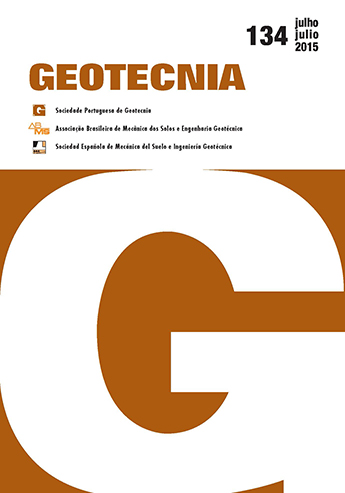Mixtures of lateritic soil and bentonite as an alternative barrier for sanitary landfills in Brazil
DOI:
https://doi.org/10.24849/j.geot.2015.134.03Keywords:
Sanitary landfill, Later, Bentonite, Hydraulic conductivity, Shear strengthAbstract
In 2014 most Brazilian cities had not yet managed to comply with the National Policy for Solid Waste (PNRS), which implies that all urban waste not recycled must be disposed of on proper sanitary landfills. In this context, the use of a barrier composed of lateritic soil seems to be a reasonable alternative to substitute or complement geosynthetic barriers, considering the abundance of this type of soil in the tropics. However, some lateritic soils may not exhibit the low hydraulic conductivity (k) levels demanded by landfill design and bentonite addition could reduce the k of these soils. This paper reports the results of laboratory research on mixtures of bentonite and a lateritic soil from the region of Ouro Preto MG, Brazil. The study aimed to determine the reduction of hydraulic conductivity of lateritic soil due to the addition of bentonite, and to evaluate the possible decrease in shear strength for application in landfill base sealing systems. The experimental work involved characterization, hydraulic conductivity and shear strength determination. As a general conclusion, the research indicated the suitability of these mixtures as an alternative for liner construction, once the interaction of the bentonite and the lateritic soil is correctly addressed.
Downloads
References
ABNT - Associação Brasileira de Normas Técnicas. NBR 6459 (1984): determinação do limite de liquidez. NBR 6508 (1984): grãos de solos que passam na peneira de 4,8 mm – determinação da massa específica. NBR 7180 (1984): determinação do limite de plasticidade. NBR 7181 (1984): análise granulométrica. NBR 6457 (1986): amostras de solo – preparação para ensaios de compactação e ensaios de caracterização. NBR 7182 (1986): ensaio de compactação. Rio de Janeiro.
ABRELPE - Associação Brasileira de Empresas de Limpeza Pública e Resíduos Especiais (2013). Panorama dos resíduos sólidos no Brasil. 11ª edição, ABRELP, São Paulo.
Anderson, S.A.; Hee, B.H. (1995). Hydraulic conductivity of compacted lateritic soil with bentonite admixture. Environmental and Engineering Geoscience, v. 1, n. 3, pp. 299-312.
ASTM - American Society for Testing and Materials. D 4767 (1995): Standard Test Method for Consolidated Undrained Triaxial Compression Test for Cohesive Soils. West Conshohocken.
Chapuis, R.P. (1990). Sand-bentonite liners: predicting permeability from laboratory tests. Canadian Geotechnical Journal, v. 27, pp. 47-57.
Chapuis, R.P.; Aubertin, M. (2003). On the use of the Kozeny-Carman equation to predict the hydraulic conductivity of soils. Canadian Geotechnical Journal, v. 40, pp. 616-628.
Cuisinier, O.; Deneele, D.; Masrouri, F. (2009). Shear strength behavior of compacted clayey soils percolated with an alkaline solution. Engineering Geology, v. 108, pp. 177-188.
Daniel, D.E.; Koerner, R.M. (1995). Waste containment facilities: guidance for construction, quality assurance and quality control of liner and cover system. ASCE, New York, 354 p.
DER – Departamento de Estradas de Rodagem de São Paulo. DER-M196-89 (1989): Classificação de solos tropicais segundo metodologia MCT. São Paulo.
DNER – Departamento Nacional de Estradas de Rodagem. DNER-ME 256-94 (1994): Solos compactados com equipamento miniatura – Determinação de perda de massa por imersão. Rio de Janeiro.
Farnezi, M.K.; Leite, A.L.L. (2007). Lateritic soil and bentonite mixtures assessment for liner usage purpose. Soils and Rocks, São Paulo, v. 30, n 2, pp. 103-112.
Gleason, M.H.; Daniel, D.E.; Eykholt, G.R. (1997). Calcium and sodium bentonite for hydraulic containment applications. Journal of Geotechnical and Geoenvironmental Engineering, v. 123, n. 5, pp. 438-445.
Head, K.H. (1986). Manual of Soil Laboratory Testing: Effective Stress Tests. John Wiley & Sons, London, v.3.
IBGE – Instituto Brasileiro de Geografia e Estatística (2011). Contas regionais do Brasil - PIB e participação das grandes regiões e unidades da federação. Disponível em: ftp://ftp.ibge.gov.br/Contas_Regionais/2011/pdf/tab01.pdf.
Koch, D. (2002). Bentonites as a basic material for technical base liners and site encapsulation cut-off walls. Applied Clay Science, v. 21, pp. 1-11.
Madsen, F.T.; Müller-Vonmoos, M. (1989). The swelling behavior of clays. Applied Clay Science, v. 4, pp. 143-156.
Mesri, G.; Olson, R.E. (1970). Shear strength of montmorillonite. Geotechnique, v. 20, n. 3, pp. 261-270.
Nogami, J.S.; Villibor, D.F. (1985). Uma nova classificação de solos para finalidades rodoviárias. In: Simpósio Brasileiro de Solos Tropicais em Engenharia, Rio de Janeiro. Anais, v. 1, pp. 30-41.
Osinubi, K.J. ; Nwaiwu, C.M.O. (2002). Compacted lateritic soils as hydraulic barriers in waste containment systems. In: International Congress on Environmental Geotechnics, 4, Rio de Janeiro. Anais, pp. 225-230.
Rowe, R.K. (2001). Barrier systems. Geotechnical and Geoenvironmental Engineering Handbook, New York. Kluwer Academic, New York, pp. 739-788.
Santamarina, J.C. (2003). Soil behavior at the microscale: particle forces. Soil Behavior and Soft Ground Construction, ASCE Geotechnical Publication, n. 119, Reston, VA, pp. 25-56.
Shackelford, C.D. (1994). Waste-soil interactions that alter hydraulic conductivity. Hydraulic Conductivity and Waste Contaminant Transport in Soil. ASTM STP1142, Philadelphia, pp. 111-166.
Sivapullaiah, P.V.; Sridharan, A.; Stalin, V.K. (1998). Evaluation of bentonite and sand mixtures as liners. International Congress on Environmental Geotechnics, 3, Lisboa. Anais, pp. 17-21.
Stewart, D.I.; Studds, P.G.; Cousens, T.W. (2003). The factors controlling the engineering properties of bentonite-enhanced sand. Applied Clay Science, v. 23, pp. 97-110.
Sunil, B.M.; Nayak, S.; Shrihari, S. (2009). Shear strength characteristics and chemical characteristics of leachate-contaminated lateritic soil. Engineering Geology, n. 106, pp. 20-25.
Vertamatti, E. (1998). Novas considerações para classificações de solos tropicais amazônicos de textura fina. Congresso Anual de Pavimentação, 23, Florianópolis. Anais, pp. 533-564.




